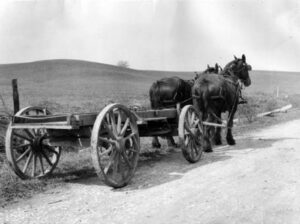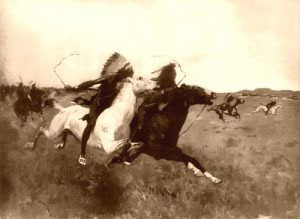The greatest Indian scare in Cloud County, Kansas, occurred in 1864. It was reported that the Confederate soldiers had partnered with Indian tribes and were warring on the frontier from Minnesota to the Gulf of Mexico. It occurred just after the great Indian Raid in Nebraska, which extended from Denver, Colorado, 600 miles east along the great overland stage route. Though the report was not true, it disastrously affected the counties along the frontier. Most settlers fled to Washington and Clay Counties, where they halted and banded together for defense. Many never returned, and most of those who did were not as ambitious to improve their farms as before.
One of the most diabolical outrages committed by the Indians was the killing of six hunters in May 1865. This party left home on about May 4 and was last seen by white men near the forks of Buffalo Creek about two days later. The story of their deaths was never fully known, as no one survived. However, clues discovered by the men who found and buried the hunters told this story:
Their outfit consisted of a team of horses, an old wagon, camp equipment, arms, and ammunition, with each man having a good rifle and a six-shooter. Buffalo were plenty, and one or more had been slaughtered and carried to the camp. When a party of Cheyenne Indians appeared at their camp unexpectedly, they began rifling it and menacing the hunters. Lewis Castle, the party’s captain, and an intense Indian hater fired upon them, wounding or killing an Indian. The Indians fled, and the hunters, aware of their inability to cope with many Indians, sought safety by flight. That course proved their destruction; for a while, it was possible for them to successfully resist an attack from under such cover as the timber and high creek banks afforded, but they couldn’t resist the assaults of Indians on the open prairie. But they chose the prairie and met their death manfully, fighting to the last.
Immediately after the first trouble, the horses were hitched to the wagon, the camp equipment was hastily thrown into it, and the men started in a northeasterly direction, intending to reach Buffalo Creek about 15 miles from their camp. Proceeding a few miles unmolested, they came upon two other hunters, sons of William Collins of Lincoln Township. Thus reinforced, their escape seemed probable when suddenly 40-50 heavily armed warriors dashed down upon them, delivering a shower of bullets and arrows before suddenly wheeling their fleet ponies and riding away at a safe distance. Though it is impossible to determine the effect of this first attack, it is almost certain that some of the little squad must have been wounded. And they returned the fire, which is as certain as anything connected with the affair. Again and again, the assault was repeated, and again and again, was it repulsed. There seems to have been a terrific struggle between the contestants. Pony tracks were thick in the rear, in front, and on both sides of the wagon, and the coarse of the fleeing men had been nearly reversed. It was, without doubt, a hand-to-hand conflict, but the little band of heroes proved more than a match for their assailants and drove them away again for the eighth or tenth time. In this last encounter, probably, at least one Indian was severely hurt, as portions of clothing were found and blood spots were seen on the ground. From then on, until within a quarter of a mile of Buffalo Creek and safety, the heroic band was unmolested. They probably would have made their escape had not an unfortunate accident happened. It was here that one of the linch-pins broke, which let one of the hind wheels of the wagon run off, and while replacing it with a wooden pin, the Indians got between them and the creek, and all hope of escape was cut off. The team was sorely tired and could make but poor speed at best. Again, the fierce and ruthless Indians assaulted them and drove them from the creek upon the open prairie. From then on, the fight continued, and the whole party was killed at the head of the Little Cheyenne, a small tributary of Buffalo Creek. Castle was the last to surrender, with his head split open with a tomahawk. Thus perished six brave men.
Robberies and outrages of various kinds occurred for several years, beginning in 1860. Horse stealing seemed to be the Indians’ peculiar weakness. A band of warriors made away with six horses from the Elm Creek settlement in 1865 but were pursued and severely punished when the settlers took 14 heads of horses and considerable camp equipment from the thieves.
In May 1865, the murder by Indians of the six hunters in Republic County created universal horror and alarm in the area.
Early in April 1867, a small band of Cheyenne found their way into the settlements on White Rock Creek in Republic County. Under the guise of being friendly Otoe, they were admitted into the home of a settler named Ward and given food. One of the Indians noticed a rifle belonging to the host and, taking it down, shot him as he unsuspectingly smoked his pipe. The two Ward boys dashed their lives, the Indians firing at and wounding one of them fatally. Mrs. Ward barricaded herself in the house and waited for the next move, who procured an ax, chopped down the door, and looted the house. The confiscated plunder was loaded on two mules, the property of Mr. Ward, and, with Mrs. Ward as a prisoner, the Indians hurriedly left to join their tribe on the Solomon. Cloud and Clay County settlers started in pursuit, but as the Indians had several days’ start, they were never overtaken. The fate of Mrs. Ward was never learned.
On August 11, 1868, threatening Indian bands appeared in the Solomon Valley, and an outbreak occurred. They began pillaging the farms of Henry Hewitt and John Batchie, who lived near the Soloman River. By a ruse, the Indians suggested shooting at buffalo heads and had the whites shoot first, then, when their rifles were empty, shot them down. News of this event traveled through the settlement, and the people began organizing for defense. The next day, three more white men were killed at Asher Creek, and while the settlers were gathering to move to a stockade, the Indians swept down upon them. Two Missel boys were captured, John Wear was killed, and Mrs. Henry Hewitt was wounded. A message was sent to Miss Jennie Paxton, who was teaching school, and she managed to get all the students safely to a nearby house, except Lewis Snyder, who was in the rear and was overtaken. He was severely hurt by the Indians and left for dead, but recovered. Benjamin White, who lived on White’s Creek, west of Concordia, was killed on August 13, and his daughter, Sarah, was carried into captivity. The same band of Indians also captured Mrs. Morgan, and six months afterward, the two women were rescued in northern Texas by General George Custer after a winter campaign.
In the spring of 1869, the Cheyenne and Arapaho again appeared in the Republican River Valley. Ezra Adkins, the 12-year-old son of Homer Adkins, who lived about six miles up the Republican from Concordia, was killed by Indians within a short distance of his home while driving home some cattle he had been herding on the west side of the Republican River. Neither boy nor pony ever returned. The Indians then destroyed the Nelson house, but the family escaped. At the same time, a man named Nelson, a Dane living near Mr. Adkins, was robbed of his team while plowing in the field.
©Kathy Alexander/Legends of Kansas, April 2024.
Also See:
Sources:
Blackmar, Frank W.; Kansas: A Cyclopedia of State History, Vol I; Standard Publishing Company, Chicago, IL 1912.
Cutler, William G; History of Kansas; A. T. Andreas, Chicago, IL, 1883.




